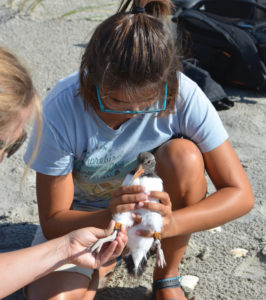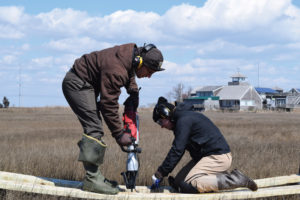Taking the Pulse of the Marsh

Banding American Oystercatchers
Wetlands and coastal ecosystems are incredibly dynamic with change being a constant characteristic. Superimposed on their rhythmic changes are intensified pressures related to climate change, sea level rise, and intense human use. As the intensity of coastal storms increases and coastal communities become more vulnerable, calls for fortification of our coasts are increasing. Whether it is expanding bulkheads, artificial filling of beaches, or raising marsh elevations with dredge material, building coastal resilience will undoubtedly impact natural areas and the plants and animals that contribute to their function. Our understanding of these ecosystems and the wildlife that are dependent upon them may ultimately be the difference in the success of coastal resilience measures.
Last year, we expanded our work to study changes that are occurring and what they mean to the wildlife here. Our office is our laboratory and work done here in these marshes and coastal systems is significant and relevant to systems along the entire east coast of the United States. The richness of the fabric of these systems is remarkable. This is a special place at the center of one of the great migrations on planet Earth. The marshes and beaches of Cape May County are critical for a wide range of birds and other wildlife. Whether they are passing through on northbound or southbound flights to breeding grounds and wintering areas, arriving here to nest, wintering here, or are part of our year-round resident populations, the importance of these ecosystems cannot be underestimated. The vast marsh complexes that make this area so rich are also the key to coastal resilience in a complex web where disturbance, human or otherwise, can have a cascading effect.

installing marsh elevation monitoring stations at The Wetlands Institute
To become the eyes and ears of the marsh, last year, we installed marsh elevation monitoring stations at the Institute with the support of the Davenport Family Foundation. This year, with their continued support, we will expand the program to include monitoring of key species and their role and relationship to the ecosystem. Information on how these species are influencing ecosystem dynamics and how their roles are changing will be instrumental in guiding engineering decisions that are being made to fortify our coasts. The understanding obtained through analysis of key marsh and coastal indicator species will help guide decisions that will impact the future of these marshes and the coastal communities that surround them.
We couldn’t undertake these projects without the support of our donors, members, and friends. As we come into the season of giving, I hope you will consider how your support can help fuel this crucial work.
